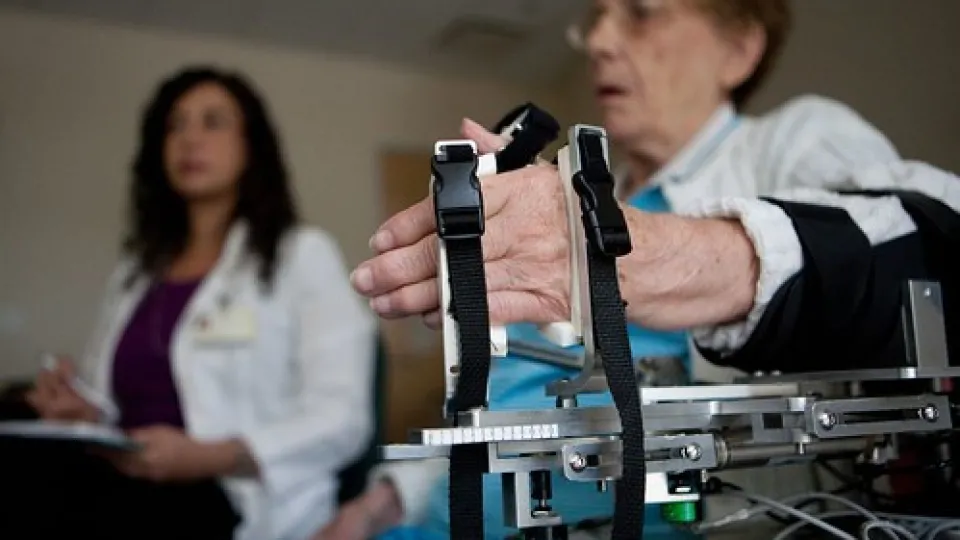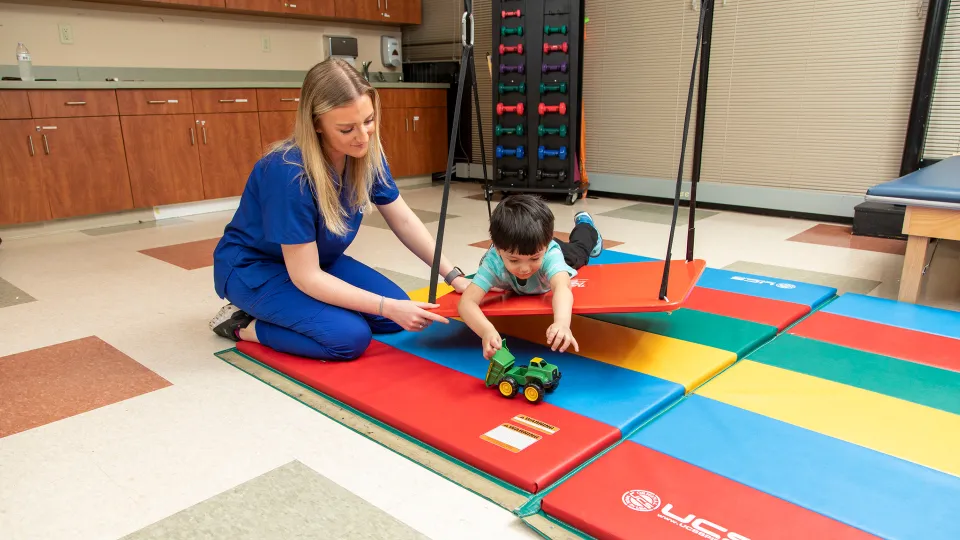
After a patient receives a diagnosis that comes with some limitations, occupational therapy can be a valuable part of their health care plan. An occupational therapist can help an individual navigate their everyday tasks as independently as possible, which can improve both their physical and mental abilities.
Learn more about occupational therapy, including what it is, why someone may need it, and what responsibilities an occupational therapist and assistant typically have.
What Is Occupational Therapy?
Occupational therapy (1), also referred to as OT, is an evidence-based therapy that helps patients adapt to physical, cognitive, or sensory problems in order to live their lives to the fullest. It's called occupational therapy because the everyday activities and tasks people perform are called occupations. OT is the process of helping someone perform routine tasks in an environment like school, home, or work.
Occupational therapy is great for those who are unable to take care of themselves, move easily, or perform a normal function in school or at work because of illness, pain, injury, or disability. The patient may be able to perform tasks with or without assistive devices, and an occupational therapist can evaluate whether one is needed and how to help the patient get used to it.
Many people may not give a second thought to their ability to perform everyday activities like transporting themselves from one place to another, tying their shoes, typing on the computer, brushing their teeth, and making themselves a meal. However, these types of activities aren't always easy for those who need occupational therapy. With a care plan in place, OT patients can learn or re-learn how to perform these everyday activities or anything else they may need help with based on their unique situation.
What Does an Occupational Therapist Do?

What Does an Occupational Therapy Assistant Do?
Two main professionals provide occupational help to patients - occupational therapists and occupational therapy assistants (OTAs). While assistants help the therapist with some parts of treatment, the occupational therapist is in charge of assessing the patient during a first visit and creating therapy plans based on what the patient is struggling with.
Occupational therapy assistants help people do the things they love, want, and need to do as part of their everyday lives. These individuals may be struggling with some part of an activity and need assistance, or assistive devices, to be able to perform the activity in full.
Occupational therapists aren't there to cure an injury, disease, or disability. Instead, they work with other health care professionals to help the individual take control of their situation and find alternative ways to perform tasks in a way that's easier or less painful for them.
One of the interesting things about both occupational therapists and occupational therapist assistants is that they take a more holistic approach to the care of their patients. This means that rather than changing something about the individual to make them fit better in their environment, they focus on making the environment or specific task work better for the individual.
Occupational Therapist Responsibilities
You now know that occupational therapists are responsible for adapting an environment or set of tasks to better fit their patient's needs, but here are a handful of other things OTs and OTAs may do on the job:
- Teach patients new ways to do seemingly mundane tasks, like working on the computer and getting in and out of the bathtub
- Organize parts of a patient's home to make life a little easier for them, such as arranging their medications or kitchen tools for easier accessibility
- Increase hand-eye coordination in individuals with vision issues
- Build up motor skills so a patient can grasp objects like their toothbrush or a pen
- Train patients to use assistive devices, like a cognitive aid or raised toilet seat
- Address fall hazards in a patient's home or popular public spaces and help the patient by providing ways to prevent falls
- Help stroke victims regain their balance and adapt to any new speech problems
- Assist families with children who have behavioral issues
Why Would Someone Need Occupational Therapy?
Anyone who struggles to perform everyday tasks may need occupational therapy. This can include individuals who have had a history with or are currently experiencing:
- Stroke: The paralysis that stroke victims experience can range in intensity and duration of symptoms. Some issues these individuals may have include loss of balance, memory and speech issues, and the inability to use a part of their body because of permanent paralysis. An occupational therapist can adapt a stroke victim's environment to help them navigate their residence without falling and communicate despite their shortcomings.
- Poor vision: Occupational therapy assistants can help a patient with poor vision in a few different ways, such as suggesting lighting in their home that will help them see their surroundings, showing them how to navigate their home safely despite their poor vision, and helping them use other parts of their vision to compensate for the area of their eye that is lacking.
- Diabetes: Individuals with diabetes have to monitor their blood glucose levels to make sure they are in a healthy range. They also need to adjust their lifestyle to promote a healthier diet and be less sedentary. An OTA can help patients with diabetes by addressing anything they may be up against, either physically or emotionally, that prevents them from taking care of themselves and living a full life despite their diabetes.
- Joint replacement: Someone with joint replacement may have a difficult time adapting to the changes in their body. An OTA can assist them with developing a full range of motion, getting in and out of bed, standing for a certain amount of time, and going up and down the stairs. An occupational therapist can prescribe any equipment the patient may need to navigate their home more effectively.
- Poor balance: People with chronically poor balance could benefit from the help of an occupational therapist to prevent falls. The OT may have a discussion with the patient about their daily activities in order to develop a fall prevention plan that makes sense for the patient's current home environment and lifestyle. This may include coming up with ways to climb stairs and identifying hazards that can contribute to falls.
- Chronic pain: An OTA may help someone with chronic pain by first understanding how their pain impacts their everyday life and how positive the patient is about their ability to control and overcome the pain. An occupational therapist can help patients with chronic pain by practicing relaxation techniques, providing them with exercises that are gentle yet effective in increasing their strength, and talking the patient through the brain's role in pain and how they can change their pain response.
- Alzheimer's disease: Someone with Alzheimer's may have problems engaging in their activities and remembering where something belongs or where to find something in their home. An occupational therapist can help them by labeling drawers and cabinets to make it easier and less frustrating to find essential items, developing stimulating activities that will keep the patient happy and busy, and providing helpful communication techniques.
- Cerebral palsy: Cerebral palsy affects a patient's muscle control, resulting in involuntary spasms and the inability to use certain parts of their body. An occupational therapist may be able to help by prescribing assistive devices, such as speech devices to help the patient communicate or a wheelchair so the patient can remain mobile. They can also help the patient adapt to a new way of performing everyday tasks based on what part of their body is affected by their disability.
- Cancer: Cancer patients commonly experience a drop in cognitive (2) and physical functioning, which an occupational therapist may be able to help with. An OT can help a cancer patient by giving them the tools to prevent falls and developing a schedule to help the patient conserve their energy while still being able to enjoy the activities they love.
- Brain injury: Individuals with brain injuries may experience difficulty with their memory or find that they are more prone to emotional outbursts. An OTA may help these patients by encouraging them to use a memory journal or teaching them anger management techniques that will help them maintain positive relationships with friends, family, and coworkers.
- Mental health issues: People often associate occupational therapy with patients who have physical difficulties. However, OTAs assist those with mental health issues as well. They can help them engage in the activities they once loved or find new hobbies and interests that excite them. OTs may identify how a patient's mental illness has affected their everyday life and work on helping them get past that either by developing coping mechanisms or finding other ways to support their values and goals.
- Behavioral issues: An occupational therapist can work with people who have behavioral problems by identifying any barriers they have and finding ways to help them connect to their emotions more successfully. For example, an OT may learn that a child's behavioral issues stem from sensory issues, which could lead them to develop activities that help the child approach their sensory experiences in a new way.
- Severe burns: Someone with severe burns has to be very careful with their movements so that they don't cause additional damage that prevents their skin from healing. An occupational therapist can help someone with severe burns by developing new ways to perform everyday tasks in order to avoid painful movements that could contribute to swelling.
What Does the First Visit With an Occupational Therapist Look Like?
On a first visit, an occupational therapist will come to the patient's home or another specified location to better understand the patient's current situation and circumstances. They'll do a physical assessment by asking the patient to perform certain tasks, and then they will evaluate what they have trouble with, what parts of the body aren't moving correctly, and how long it takes to complete the tasks.
An OT may also assess a patient's mental abilities to find out how the brain processes certain information or stimuli - as well as what it can't process. Armed with this information, the occupational therapist then evaluates the patient's environment and how they navigate through it.
During the first visit, the OT will ask the patient questions about what's most important to them and what they hope to get out of treatment. Once the occupational therapist has a firm understanding of where the patient is struggling, they'll put together a therapy plan that accounts for the patient's goals and helps them fulfill their needs no matter their physical or mental limitations.
They'll also come up with a schedule for therapy depending on the patient's needs and the severity of their limitations. In subsequent sessions, the OT should evaluate the patient's progress and make sure that they are meeting their goals. If the patient has any feedback, the OT and OTA may work together to change the therapy plan in order to accommodate their needs. The goal is to help patients adapt their movements and improve their skills so that they can lead as independent and normal lives as possible.
Where Does Occupational Therapy Take Place?

Where Do Occupational Therapy Assistants Work?
Occupational therapy can take place in any setting that is proving difficult for the patient. Therefore, you can find occupational therapy assistants performing their work in the following locations:
- A patient's residence
- Rehab centers
- Schools
- Nursing homes or assisted living facilities
- Outpatient clinics
- Workplaces
- Hospitals
OTs and Occupational Therapy Assistants are often a crucial part of a patient's recovery and rehabilitation process. While doctors may prescribe medication to help a patient manage pain, an occupational therapist will work with that same patient to help them handle their everyday tasks without pain flareups. If you want to learn to help patients realize an independent and fulfilling life that isn't defined by their injury, illness, or disability, explore Concorde's Occupational Therapy Assistant program. You can earn a degree in as little as 19 months.
Interested In How To Become an Occupational Therapy Assistant?
Click here to explore Occupational Therapy Assistant Programs near you!
Footnotes
(1) "About Occupational Therapy," American Occupational Therapy Association, https://www.aota.org/About-Occupational-Therapy.aspx
(2) "Cognitive Impairment Associated with Cancer," Innovations in Clinical Neuroscience, https://www.ncbi.nlm.nih.gov/pmc/articles/PMC5819720/
(3) Image via Flickr by uci_innovation, https://www.flickr.com/photos/uci_innovation/18426036742/sizes/m/
Take The Next Step Towards a Brighter Future
Interested in learning more about our Occupational Therapy Assistant program?
We have a Concorde representative ready to talk about what matters most to you. Get answers about start dates, curriculum, financial aid, scholarships and more!







